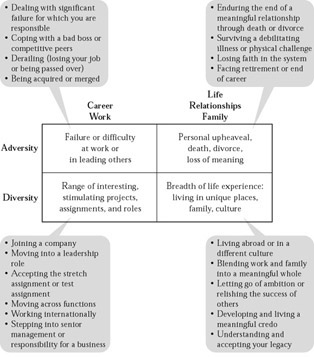Leadership Development That Includes Learning from Passages
The good news is that the passages can serve as a career roadmap. If you’re aware of what the passages are and how to go through them, you’ll learn and grow from each experience. And this constitutes effective leadership development. To understand how this leadership learning and growth takes place, let’s look at a 2 x 2 matrix (Figure 1.2) that puts it in perspective.

Figure 1.2: Leadership Learning.
Contrary to the conventional wisdom, the matrix shows that there’s more to leadership development than taking on a variety of work challenges. Although work diversity is one quadrant of the matrix, the other three are equally important. Some companies today are beginning to acknowledge that failure is a powerful teacher. The best leaders experience job and career setbacks and learn from them; they grieve and integrate the lessons learned from personal failures and tragedies, and they make an effort to live a life filled with a wide range of people, places, and events.
The combination of diversity and adversity, cross-hatched with personal and professional experiences, drives leadership learning and growth. More specifically, it’s a leader’s willingness to reflect, face into, and talk about what he’s going through that facilitates his development. Unfortunately, many companies don’t encourage reflection, conversation, and openness. The personal side of the matrix is generally ignored, and job adversity, especially any type of failure, is viewed with disapproval. In succession-planning discussions or promotion decisions, failure, setbacks, and reversals are entered on the negative side of the ledger. And yet good leaders fail frequently. Although some of these failures are public and spectacular, such as a CEO missing the analyst projections for three quarters in row, many are private and partial. It’s not unusual for someone to do well with one aspect of an assignment and not so well with another. For example, leaders may succeed in mastering the technical or financial aspects of their job but fail to develop or engage people.
We have learned from coaching many senior leaders that some individuals are often continuously promoted; they show outward evidence of success but feel like failures inside. They don’t believe they deserve success because of their perceived inadequacies or self-criticism. And in every organization, you’ll find leaders who are very successful professionally and very miserable personally, and the gap between their two lives is gradually eroding their spirit.
At times of adversity, people experience teachable moments. These are windows for learning, for making quantum leaps in emotional intelligence. The individual who enjoys one success after another may become very proficient at what she does but will never grow much as a leader. The person who has some adversity mixed with the success, however, will gain insights that translate eventually into effectiveness.
When you struggle with a stretch assignment, for instance, you have the chance to analyze what’s behind this struggle. Perhaps you’re not prepared to handle a task that calls for you to function in an ambiguous environment. Maybe you’re finding that you’re missing a skill that’s necessary for the assignment. If you reflect and talk about the situation and are open to revealing where you’re coming up short, you’ll acquire self-knowledge that will serve you well in the future. You’ll work at functioning more effectively amid ambiguity or at acquiring the missing skill, and the next time you need it, you’ll either have it or you’ll realize that you need to find someone else to help you.
Although everyone experiences adversity and diversity in unique ways, the general nature of these experiences can be predicted and prepared for. When you know the passages you will encounter, you’re better able to maximize their value as learning tools. As you may have noticed when looking at the list of passages, they’re organized according to the four quadrants of the matrix: (1) diversity of work experiences, (2) work adversity, (3) diversity of life experiences, and (4) life adversity. To give you a sense of how these passages can benefit a leader, let’s look at the experience of one fast-track executive who was derailed by someone he considered a bad boss.
EAN: 2147483647
Pages: 121